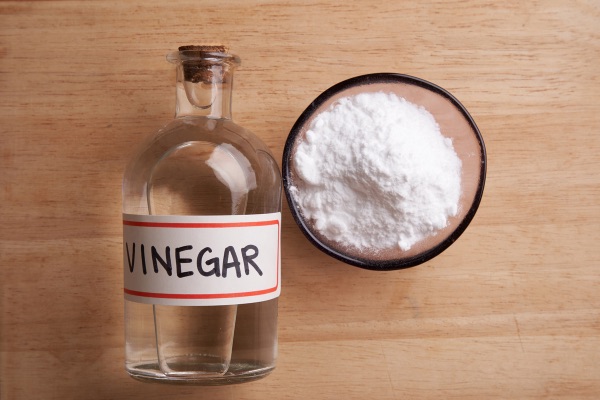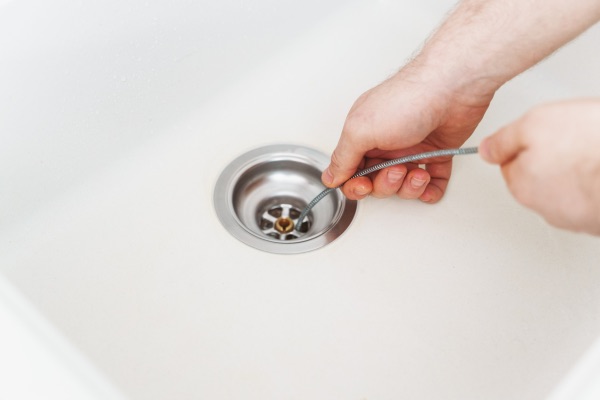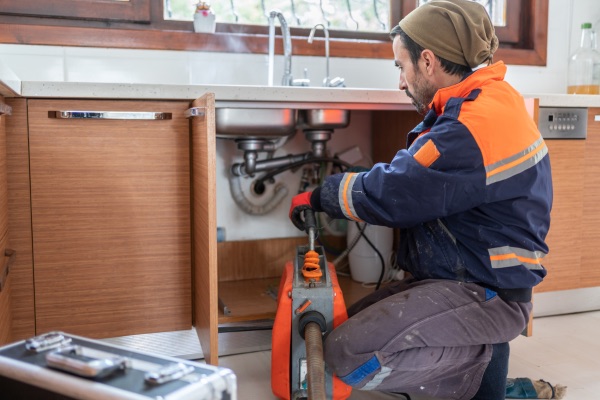So you’ve noticed the water in your sink or shower just isn’t draining right. A clogged drain? It’s frustrating, I know. Maybe you’ve poked down as far as you can reach, but nothing’s working- the water still won’t go down the drain. Before you go grabbing the strongest drain cleaner you can find, let me stop you right there. We’ll get into what plumbers do to fix clogged drains—and, more importantly, what they don’t do. Stick with us at AC Pros HVAC and plumbing services, and we’ll get your pipes flowing smoothly again.
DIY Drain Unclogging Tips

Now, before we dive into the tools and techniques the pros use, let’s talk about what you can try at home for minor clogs.
- Baking Soda and Vinegar: Here’s a classic fix. Pour some baking soda down the drain, follow it with vinegar, and let it bubble. Wait about 15 minutes, then flush it with hot water. Works on small clogs—nothing too serious.
- Baking Soda and Salt: If you don’t have vinegar, mix baking soda with salt. Half a cup of each, pour it in, and let it sit for a while. Flush with hot water, and it might just clear things up. If not, it’s time to call in the cavalry.
If these don’t clear things up, it might be time to call in the cavalry.
What Plumbers Don’t Use: Red Flag!
Now, a lot of folks figure they can dump some heavy-duty drain cleaner in and be done with it. But here’s the thing—real plumbers don’t touch that stuff, and you shouldn’t either.
- Why Plumbers Avoid highly-corrosive drain cleaners: First off, these chemicals emit toxic fumes. I don’t know about you, but I prefer to breathe clean air. Second, they don’t always dissolve the entire clog, so you’re left with part of the blockage, which will come back to haunt you. Worst of all, these cleaners can damage your pipes, leading to expensive repairs down the line. If your plumber suggests using these, consider finding a new plumber.
- You can read more about Drain Cleaner Poisoning here.
You’re much better off with the tools the pros rely on.
1. A Good Ole Fashioned Plunger
A plunger might seem simple, but it’s often the first line of defense against a clogged drain. Not just for toilets—oh no—plungers work on sink drains, showers, and tubs, too.
- How It Works: You’re creating suction, plain and simple. The plunger pulls up whatever’s blocking the pipe, so it can loosen and flow away.
- When It’s Useful: If you’ve got standing water, the trusty plunger can often do the trick. But don’t go thinking it’s a magic fix. It works on minor clogs, but anything too deep or too solid, and you’ll need more than a plunger.
2. Manual Drain Snakes (aka Plumbers Snake)

The manual drain snake is a step up from the plunger. This coiled wire gets down in the drain and pulls out or breaks up the clog.
- How It Works: You feed the snake into the drain, and when it hits the clog, you either twist it to break up the blockage or pull it out. It’s a straightforward tool, but highly effective for most home drain problems.
- -When It’s Useful: This is for when the plunger just doesn’t cut it. Manual snakes are great for tougher clogs in sinks and tubs, especially when hair is involved.
- -Why It’s Better Than a Plunger: A snake gets deeper into the drain than a plunger ever could, and it’s much better at grabbing things like hair or gunk stuck to the sides of the pipe.
3. Powered Drain Snakes
If manual labor isn’t cutting it, that’s when plumbers bring out the powered drain snake. This is basically a drain snake on steroids.
- How It Works: A motor powers the snake, allowing it to go deeper and push with more force. This makes it ideal for serious blockages or those farther down the line.
- When It’s Useful: If you’ve got a stubborn clog that just won’t budge, powered drain snakes are what plumbers turn to. They can handle tougher blockages that manual snakes might struggle with.
4. Drain Auger
A drain auger is a bit different than a snake, though people sometimes confuse the two. Augers are thicker, less flexible, and built to power through bigger blockages.
- How It Works: The auger is designed to muscle through tough clogs. Whether it’s manual or motorized, this tool breaks up whatever’s blocking the drain, using more force than a snake.
- When It’s Useful: You’ve got a serious blockage? An auger will get through it. It’s the linebacker of plumbing tools—strong and straightforward.
5. Hydro-Jetting Machines
Now, when things get really bad, plumbers might turn to a hydro-jetting machine—also called sewer line jetting or water jetting. This method uses high-pressure water to blast away blockages in your pipes.
How It Works: A powerful stream of water, strong enough to cut through tree roots and built-up debris, is sent through your pipes. Hydro-jetting not only clears the clog, but it also scours the inside of the pipes, leaving them clean and free from grease, sludge, or other gunk.
When It’s Useful: Hydro-jetting is the go-to solution for major blockages in the sewer line or drain lines, especially when things like grease, scale, or tree roots are causing problems. It’s ideal for tougher clogs that standard tools just can’t handle, ensuring your pipes are clear from buildup and operating efficiently again.
6. Pipe Inspection Cameras
When a plumber can’t quite pinpoint the problem, or if there’s suspicion of something more serious, they’ll breakout the high-definition sewer line camera. This tool lets them take a look inside the pipes without the need to tear up your yard or walls.
How It Works: A small, high-definition camera is attached to a flexible cable and fed through the pipes. The plumber watches a live feed on a monitor, allowing them to see exactly what’s going on inside—whether it’s a blockage, a crack, corrosion, or even tree roots.
When It’s Useful: A camera inspection is typically used when clogs are recurring, or when a plumber suspects there’s more than just a simple blockage, such as damaged or collapsed pipes. It’s also common when dealing with sewer line issues, helping plumbers figure out whether sewer line jetting is needed or if a bigger repair, like pipe replacement, is required. It’s a smart, non-invasive way to get a clear picture of the problem and the best course of action.
Auger, Snake, Cable? What’s the Difference?
Now, you might hear a lot of different terms thrown around when it comes to clearing drains—auger, snake, drain cable, cable cleaning, hair snake, plumber’s snake, and even electric drain cleaner.
Honestly, some of these terms get used interchangeably, even by the pros. For example, a plumber’s snake and a drain cable are often talking about the same tool—just depends on who you ask. Sometimes you’ll see them called ‘hair snakes’ to pull clogs out of sinks and shower drains- much more useful than the Medusa kind.
The important part is making sure you’ve got the right tool for the job, and if you’re not sure, a pro will know which tool (or snake) to reach for.
Trust the Pros for Tough Clogs

While some minor clogs can be resolved with home remedies like baking soda and vinegar, others require the expertise of a professional plumber. From plungers and manual snakes to high-powered tools like hydro-jetting machines, plumbers have an arsenal of options to clear even the most stubborn blockages.
If you’re dealing with a clog that home remedies can’t fix, don’t hesitate to call in the pros. AC Pros is here to help you with professional and safe drain-clearing solutions, ensuring that your plumbing system runs smoothly without the risk of damage. Let us handle the tough clogs, so you can get back to enjoying a fully functional home.
Keep Reading:Avoiding Plumbing Disasters During the Holiday Season: Expert Tips to Keep Your Pipes Flowing Smoothly
